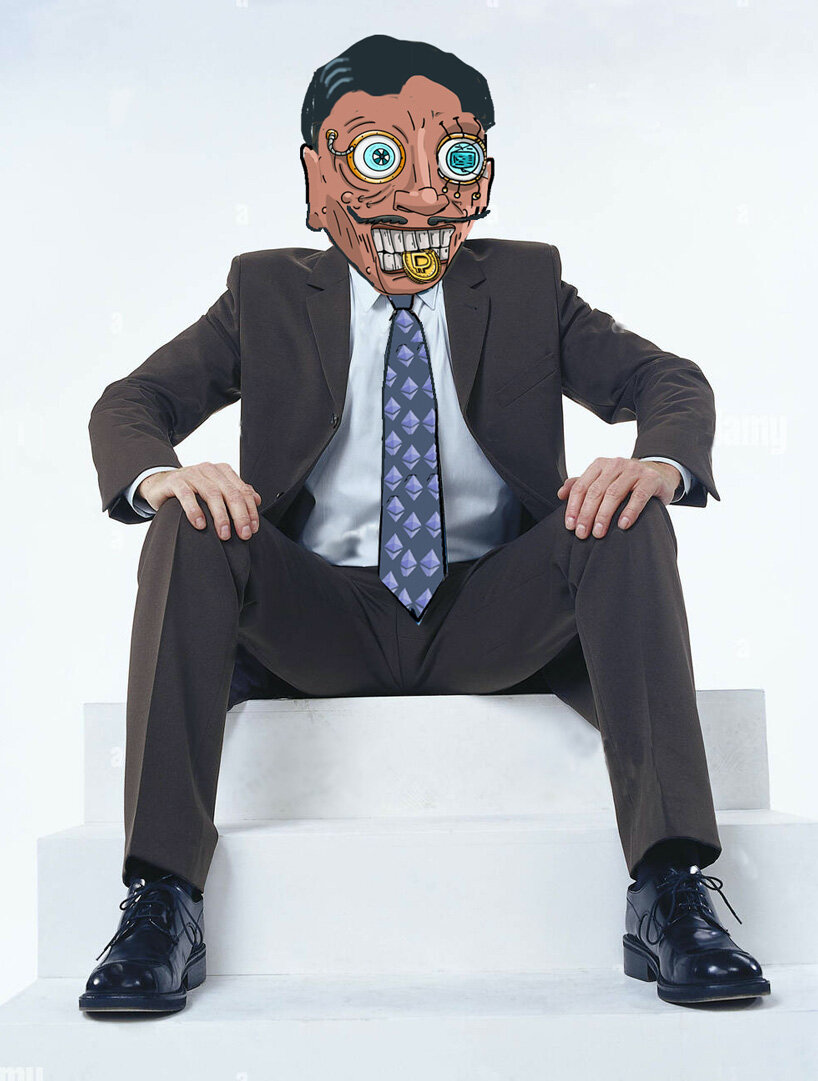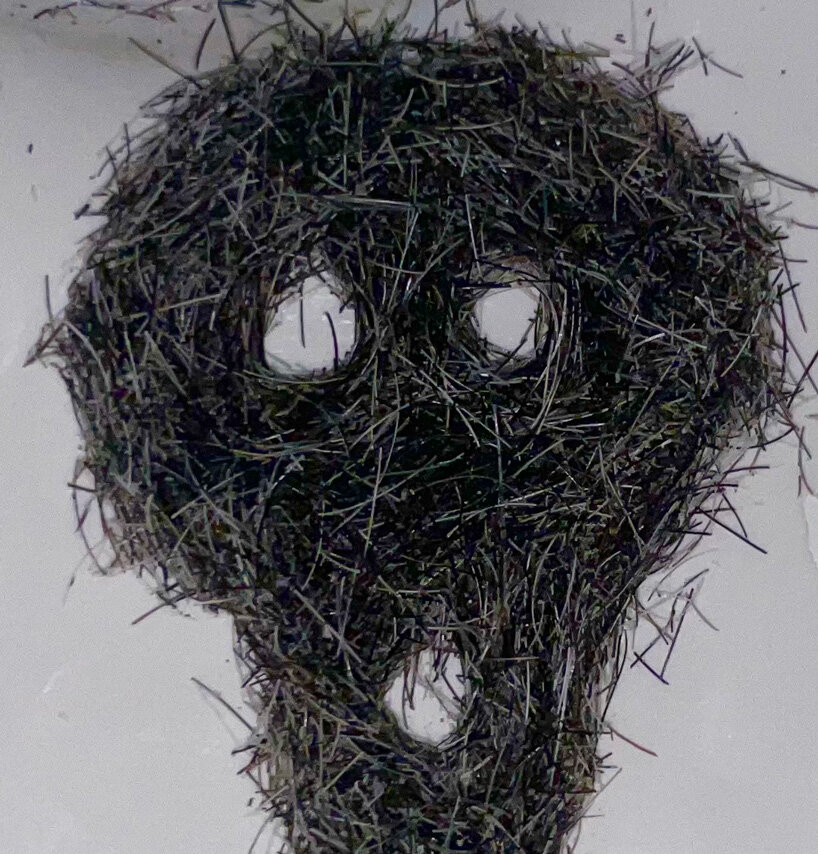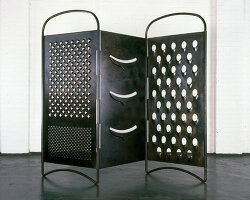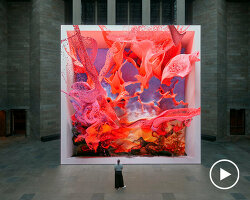exploring the role of emerging technologies at nft art day zrh
As the digital renaissance continues to reshape the art world, the annual NFT ART DAY ZRH conference returns to Zurich for its second edition to delve deeper into the burgeoning realm of NFTs, Web3, and contemporary digital art. From June 10 to 11, the platform will bring together some of the most prolific players in the art world — from museums and directors, to collectors, critics, artists, and enthusiasts — to explore the intricate intersections between art and technology through the lens of blockchain and NFTs. Among these, artist and critic Kenny Schachter will be returning to lead the event’s keynote address, with an agenda to build bridges between the disparate camps of the traditional and digital art worlds — or ‘militias’ as he playfully calls them.
As media partner of NFT ART DAY ZRH, designboom spoke with Schachter ahead of the event to uncover his insights on the evolving landscape of digital art, the impact of NFTs on the industry, and a deeper look at his recently-launched art game POP PRINCIPLE. Read the interview in full below, and keep up to date with more news and interviews from the conference here.

Kenny Schachter at NFT ART DAY ZRH 2022 | image by KONXHELI STUDIO
interview with kenny schachter
designboom (DB): Can you give us an overview of the key themes that your keynote speech at the upcoming NFT Art Day will touch upon?
Kenny Schachter (KS): I always try to present a snapshot of what the problems are, and what I foresee how things will transpire in the near term. There’s very much a great schism between the traditional world and the crypto art world, whether you call it NFT art or blockchain art, or just simply digital art. And I think we don’t need bridges — we need to blow the bridges up between these camps. But also, I am the bridge. I’m probably among the most entrenched in the traditional art world that’s cottoned on to NFTs and crypto art, and I speak for both constituencies.
I’m looking forward to NFT ART DAY and I’m looking to do something provocative. It’s going to be like a litmus test, a snapshot of where we are in June 2023 in relationship to the confluence of these different spheres of artistic practice and how they’re getting along. I don’t have the conclusions yet drawn, but I would like to say that NFT ART DAY is the most significant coming together of these two disparate worlds.

The Plight of Traditional Banking (Crypto’s Looking Better) | image © Kenny Schachter
DB: From your participation last year to now, do you feel that this stigma around digital technologies in the traditional art world has changed at all?
KS: It’s definitely worse. Nothing’s improved at all. What is contemporary art if not a reflection of the social, economic, and technological times we live in? We’re in a digital renaissance, and it’s all a continuum in the history of art making. But there is this resistance that’s deeply ingrained in the psyche of the traditional art world that still more than anything in the world that embraces painting on canvas. Mainly because of the fact that they’re portable, easy to buy, sell, and store — all the reasons you think that digital art would be even more accepted. But human nature recoils from innovation, newness, and change, especially when it is as complicated as blockchain and technology. And all of this talk about the nefarious nature of AI etc. — the problem is not the technology. The problem is into whose hands it falls.

Pawn Hub, 2023 | image © Kenny Schachter
DB: Your NFT art game POP PRINCIPLE touches upon these themes of disparity between the traditional and digital camps. Is this what led to the game being developed?
KS: Yes. Initially, the game was going to be more of a battle in the traditional sense, but a non-lethal one. I made a conceptual piece that I dropped on Nifty Gateway a year or so ago. And initially, I was going to flesh that out into an actual game. I coined this word ‘NFTism’ and I changed it later to ‘post-NFTism’ because in two short years, the collectible art space copied the worst attributes of the art world. And really the art market, it becomes this kind of vast popularity contest, where success affirms success, and people only want what’s succeeded in the recent past. The name POP PRINCIPLE is similarly a play on pop art, and also popularity, because the art market is a giant economic popularity contest. And people misread popularity for value, which is a mistake.
In the game, the player represents the collector. And I think the collector being actively engaged in the process of it all is exciting. David Bowie of all people was really inspired by when the internet in the 90s really started to really develop – he said the internet is reducing the gap between the artist and the audience. And this is one of the key components of Web3 and NFTs.
DB: What do you aim to achieve with POP PRINCIPLE?
KS: We need to create new bridges and I’m interested in new models and new ways of collaborating and raising new conversations. In a reductive art market, whether it’s the NFT market or fine art market as they exist today in these demarcated zones, I’m interested in fostering change and creating conversations amongst these different communities.
But I never really get to speak about it. In the art world, nobody wants to talk about art, all they want to talk about is where’s an artist showing, how much they could auction, and where’s the next show. And since I’ve been involved in the digital art world, I’ve created relationships with mathematicians, physicists, programmers, coders — people that I never would have met in my previous incarnation as a solely art world practitioner.

Duchamp’s Regret, 1993 | image © Kenny Schachter
DB: Despite the hostility around NFTs, do you think they have brought about any positive impact in the art sphere?
KS: Art to me is two things: it’s a means of expression and a means of communication. For me, NFTs offered the potential of an entirely new model to do both. At their best, NFTs are a paradigmatic shift in what art is and what it could be, how it’s made, and the functionality of it, instead of just being on the wall and in a one-way relationship.
So if you own an NFT, it’s not fixed, it’s dynamic and transformative in an organic way and that never existed in the medium of fine art where you can have an artwork that isn’t just an artwork, it’s something that’s alive. That’s the positive side of what art should be about — about means of engagement and communication amongst people.
DB: How has your own relationship with the new technologies of the day evolved over the decades of your career?
KS: Nothing has changed from day one! When digital video tape came out, I pivoted to that. When computer printing expanded in scale and materials it could be applied to, I made oversized manipulated prints outputted on vinyl developed for advertising in an art context. My first computer animation I exhibited in a show I organized myself in 1993 — largely because no one else would undertake such an affair. So I took matters into my own hands, not too dissimilar to the way I work now. In other words, I have always enjoyed (well, it wasn’t necessarily joyful all the time) a life lived in art and as we live in an age increasingly defined by technology, I’ve utilized computers and technology from the onset of my career. In that regard, not a thing has changed over more than 30 years. It’s hard for me to fathom the vitriol and resistance to crypto art and the blockchain rather than embrace the tools at hand in an opportunist fashion as artists have done since art came off the walls of caves.

CryptoMutts | image © Kenny Schachter
DB: What are you currently working on?
KS: I’m working on a project with the platform Async called Open Book and it’s a book that never ends. I curated 20 artists, a critic, and a curator — including Krista Kim, Jerry Saltz, and Hans Ulrich Obrist, to make contributions about what they like about NFTism and what their criticisms are. And then the other section is post-NFTism. Over time, people will be able to add their own thoughts to the topics, and that will become part of the book.
DB: How do you think traditional artists can bridge over into embracing these new technologies while retaining the essence of their work?
KS: I’ve spoken to traditional artists that are scared that if they start making digital art it might cannibalize their traditional art market. But the majority of contemporary artists use digital means along the way in some process of conceptualizing their work. Whether it’s painting or sculpture. So I think anyone who employs digital means in the making of their art should consider whether or not making a foray into blockchain would make sense for them. For me, art equals freedom. A freedom from norms, constraints, and artificial constructs.
I spoke to a very successful young-ish artist represented by a top gallery who phoned me early on the days of NFTs and mentioned he’d always been making animations alongside his paintings. I invited him to join a group show I curated, Breadcrumbs, at Nagel Draxler in Cologne, Germany in the Spring of 2021. He said he’d like to participate but he was afraid any success in the NFT space would cannibilize his primary art market. How sad that so many things in terms of a zero sum game: one thing or person succeeds at the direct expense of something or someone else. A very narrow, reductive way to go through life and antithetical to art.

Brice Marden feat. Kermit, 2018 | image © Kenny Schachter

Dot Pigeon Quits NFTs Over Excessive Gimmicks, What a Schmuck, 2023 | image © Kenny Schachter

Pepe-ism, 2022 | image © Kenny Schachter

All Apologies, 2019 | image © Kenny Schachter



project info:
conference name: NFT ART DAY ZRH
speaker: Kenny Schachter | @kennyschachter
conference location: Auditorium Kunsthaus Zürich
conference date: June 10-11, 2023
all conference participants: James Bridle, Brian Droitcour, Luba Elliott, Alex Estorick, Sabine Himmelsbach, IX Shells, Dr. Omar Kholeif, Mario Klingemann, Sandra Nedvetskaia, Hans Ulrich Obrist, Operator, Kenny Schachter, Anne Spalter, thefunnyguys (Le Random Collection), and Valerie Whitacre.
Tickets for NFT ART DAY ZRH are available here.
ART INTERVIEWS (112)
DIGITAL ART (118)
KENNY SCHACHTER (4)
NFT (NON-FUNGIBLE TOKEN) (101)
NFT ART DAY ZRH (7)
PRODUCT LIBRARY
a diverse digital database that acts as a valuable guide in gaining insight and information about a product directly from the manufacturer, and serves as a rich reference point in developing a project or scheme.


























